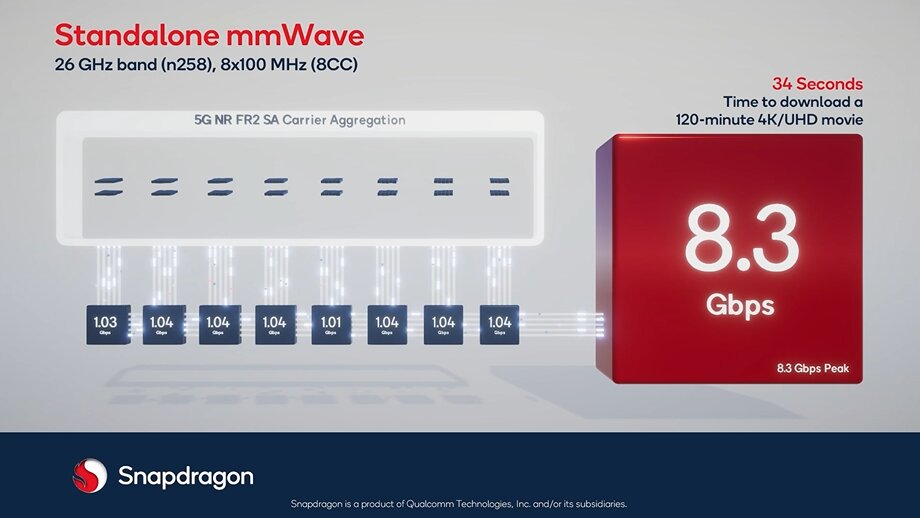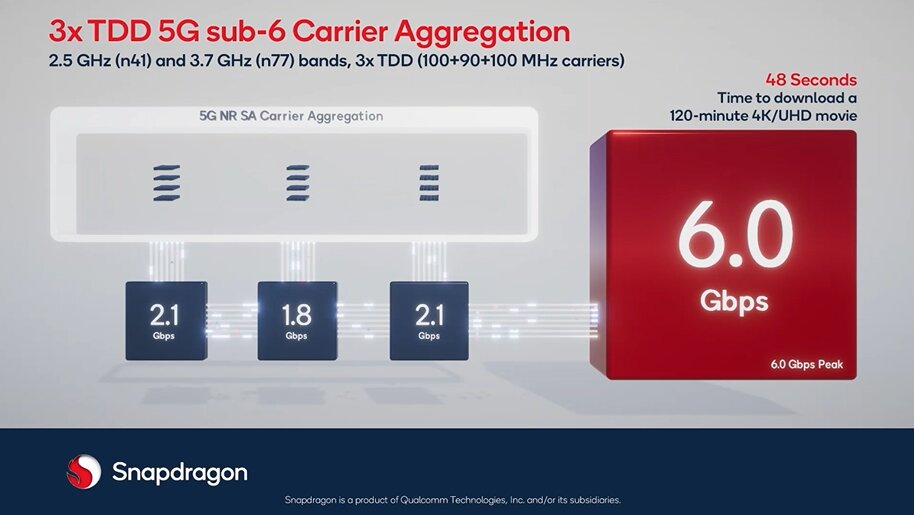At the 5G Summit in-house exhibition, Qualcomm announced the successful establishment of a 5G SA connection in the millimeter wave spectrum without the usually required anchor in the sub-6 GHz spectrum. Qualcomm's 5th generation modem RF solution is expected to be used in the first smartphones by the end of the year.
Qualcomm was able to successfully set up the pure mmWave connection in its own laboratory at the company's location in San Diego and achieve a speed of 8.3 Gbit/s in the downlink. The Snapdragon X70 with integrated AI processor presented at the MWC at the end of February is designed for speeds of up to 10 Gbit/s in the downlink and 3.5 Gbit/s in the uplink. At the 5G Summit, however, the focus was less on the throughput achieved by the modem and more on the type of connection.
The connection was established between a test device from Qualcomm, which was already equipped with the Snapdragon X70, and the Protocol R&D Toolset from Keysight, which offers test devices for the development of 5G devices. At this point, a distinction must be made between success in the laboratory and trials in the wild.
8CA with 800 MHz for 8.3 Gbit/s
Qualcomm has succeeded in establishing a connection over eight frequency blocks (8CA) each with 100 MHz in the 26 GHz band (n258) of the so-called Frequency Range 2, so that a downlink of 8.3 Gbit/s is possible over a total bandwidth of 800 MHz was. The link was set up “standalone” (SA), i.e. without an anchor band in the sub-6 GHz spectrum, nor with the support of a 5G frequency in this lower 5G spectrum, also known as Frequency Range 1. The n258 band is in the K-band from 24.25 to 27.50 GHz and enables carriers of 50, 100, 200 and 400 MHz bandwidth.
 5G SA mmWave connection with 8CA at 26 GHz (Image: Qualcomm)
5G SA mmWave connection with 8CA at 26 GHz (Image: Qualcomm) Anchor band common in the sub-6 GHz spectrum
With 5G (in Germany), logging into the network is still done with an LTE anchor band, which is also used for telephony. 5G in the non-standalone (NSA) variant is then added as a pure data channel for fast downloads and streaming. An exception to this is primarily Vodafone, which is already relying extensively on 5G standalone, which, among other things, reduces the energy consumption of the smartphone. LTE is still used for telephoning, although 5G with VoNR (Voice over New Radio) also supports this function. With mmWave, it has also been necessary to log into the network in the sub-6 GHz spectrum either via LTE or 5G. Qualcomm's laboratory test shows that pure mmWave connections are also possible with the Snapdragon X70.
3CA TDD for 6 Gbit/s
h2>
At the 5G Summit, Qualcomm also showed a connection over three TDD channels (time division duplex) in the sub-6 GHz spectrum, which achieved 6 Gbit/s in the downlink. Three carriers (3CA) of the n41 (2.5 GHz) and n77 (2.7 GHz) bands were combined.
 5G sub 6 GHz connection with 3CA TDD (Image: Qualcomm)
5G sub 6 GHz connection with 3CA TDD (Image: Qualcomm) Snapdragon X70 comes at the end of the year
The Snapdragon X70 is currently being sampled by customers and should be used in the first smartphones by the end of the year. The 4 nm modem is expected to be used as an integrated solution in the successor to the Snapdragon 8 Gen 1.
ComputerBase has received information about this article from Qualcomm under NDA. The only requirement was the earliest possible publication date.